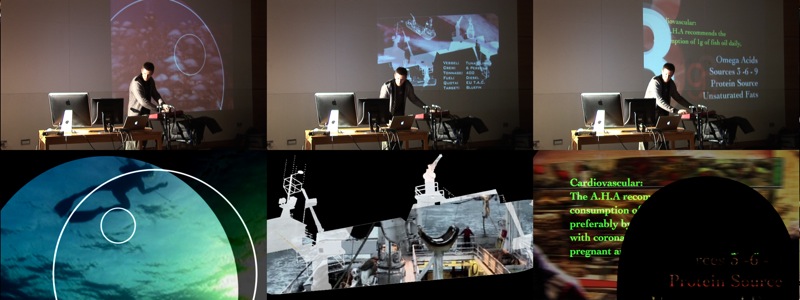
the performance, in 3 parts, with the live setup shown
over its corresponding visual screenshot. © L. McCarthy. Used with permission.
Live Visuals, Leonardo Electronic Almanac, Volume 19 Issue 3
ISBN: 978-1-906897-22-2
ISSN: 1071-4391
Volume Editors: Lanfranco Aceti, Steve Gibson and Stefan Müller Arisona
Editor: Ozden Sahin
Gathering Audience Feedback On An Audiovisual Performance
by Léon McCarthy
This paper will report on the use of video-cued commentary as a method of gathering insightful audience feedback on an audiovisual performance.
Through my current audiovisual performances, I seek to present perspectives on social themes. Hence, I hope to communicate with audiences on an intellectual level, yet in the past, I have been unable to tell whether audiences were engaging sensually, intellectually or otherwise.
My research seeks to glean in what manner audiences engage with a performance, ascertaining what elements of my performance may have triggered them to engage. I expect that in seeking answers to these questions, I will understand more about how audiovisual content, gesture and stage-setup can lead audiences to engage intellectually.
I have used post-performance audience surveys to gather subjective feedback. The analysis of these surveys revealed useful general impressions, yet feedback rarely revealed the impact of specific audiovisual events or moments. Seeking feedback on specific events could isolate the impact I had on the audience making it impossible to replicate the same impact in future performances.
In seeking to gather specific feedback, I came across the use of video-cued commentary, a method used to assess user-experience within interactive installations. [1] I adapted this approach to the field of live audiovisuals, inspired by the writings of Sergei Eisenstein [2] and adopting the listening modes suggested by Michel Chion. [3]
The design, implementation and analysis of a video-cued commentary will be part of this analysis together with alternative uses of the video-cued commentary for researchers and practitioners in other fields.
[1] B. Costello, “Many Voices, One Project,” in Interacting: Art, Research and the Creative Practitioner, eds. L. Candy and E. A. Edmonds, chapter 4.1 (Faringdon, Oxfordshire: Libri Publishing, 2011).
[2] S. Eisenstein, “Eh! On the Purity of Film Language,” in The Eisenstein Reader, ed. R. Taylor, 128–33 (London: British Film Institute, 1999).
[3] M. Chion, “The Three Listening Modes,” in Audio-Vision : Sound on Screen, ed. and trans. Claudia Gorbman (New York: Columbia University Press, 1994), 26–32.
Full article is available for download as a pdf here.
Volume 19 Issue 3 of Leonardo Electronic Almanac (LEA) is published online as a free PDF but will also be rolled out as Amazon Print on Demand and will be available on iTunes, iPad, Kindle and other e-publishing outlets.
